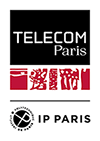
Here are the tools you need on your machine to follow INF203 labs:
Open a terminal.
You see a line with the name of the machine followed by % and a blinking cursor. In Powershell, there is the name of the current folder and > before the cursor. This line is the “prompt”.
Each Linux command has a name:
ls — to list files and folderspwd — to show the location of the current folder (print working directory)cd — to change to another directorySome commands require arguments. To change the current folder, you have to know, change to what ? Arguments are added to the name of the command:
cd workspace — to go to folder workspace (supposed to be in the current folder)cd .. — to go to the parent folder, the one containing the current folder.
. — is the current folder.. — is the parent folderTry more commands :
Try pwd↵
If you are using a PC from Télécom, the answer is: /cal/homes/votrelogin
We are using the symbol → to indicate the answer from the system, so:
Try pwd ↵
→ /cal/homes/votrelogin.
Try ls↵
→ The system prints the list of files and folders in the current folder.
Play some more with cd, pwd and ls.
You will also need a place with a web server, such as the personal pages of Telecom.
Some labs will not work if you stay “local”, i.e. if you leave all your files in a folder and you access them directly by “Open File” in the browser. You need to install a web server and use a folder in its server root, for example.
Telecom Paris offers a web container accessible via the school server. The documentation for this service is there. To activate this personal pages service, you have to go to Http://moncompte.telecom-paris.fr.
However, you may also install a web server on your own machine if you choose.